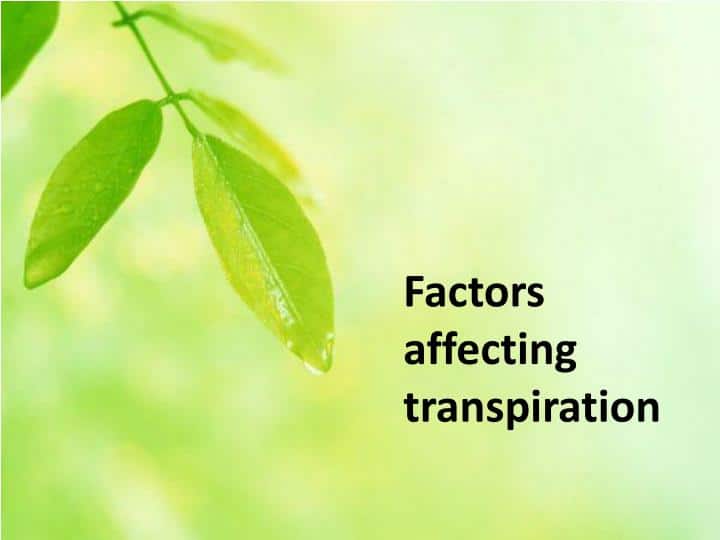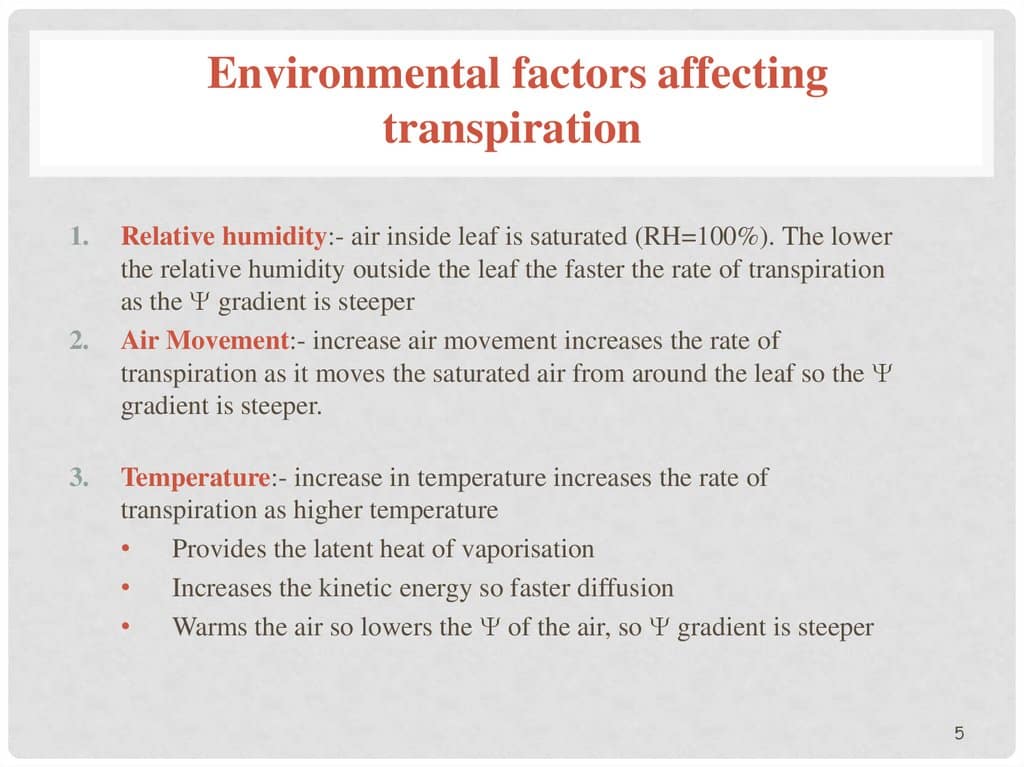Transpiration can be defined as the loss of water by evaporation in terrestrial plants.
The rate at which the water vapor is lost to the plant stomata depends on several factors that are interrelated, and of equal importance.
Factors affecting the rate of Transpiration
The factors affecting the rate of transpiration can be categorized into two – Internal factors and external factors.
The internal factors are related to the nature of the plants, such as the size of the plant stomata while the external factors are natural elements such as temperature, humidity, etc.
External Factors affecting Transpiration
- The size of the Stomatal pores
For transpiration to occur in a leaf, the stomatal pores must be open.
How much water is lost by the leaves depends on how wide each stomatal opening is, that is the size of the stomatal pore.
It was stated earlier that the size of a stomatal pore depends on the turgidity or flaccidity of the guard cells flanking it.
The guard cells are constructed such that their walls alter with changes in turgor.
The inner walls of the guard cells ( that is, those closer to the pores) are usually thicker than the outer walls ( those adjacent to the epidermal cells) As water is drawn into the guard cells from the epidermal cells, the volume and turgor of the guard cells increase.
The thin outer walls stretch and curve more than the thick inner walls.
As the former push into the surrounding epidermal cells, they pull the latter with them. This causes an increase in the size of the pore.
As water is drawn out of the guard cells, the turgor of the latter decreases, causing a decrease in the volume.
Both the inner and outer walls return to their original position as they are elastic. This causes the closing of the pore.
It is an observed fact that in the majority of plants, the stomata open in the light and close in the dark.
The relationship between the degree of turgor of the guard cells and the amount of light present lies in the carbohydrate content of the guard cells.
Carbohydrates can be present in the guard cells in the form of soluble sugar or insoluble starch and can be inter-converted from one form to the other by the agency of certain enzymes in the cells.
Whether more starch or sugar is present is directly connected with the amount of light available.
Generally, when light is present, it has been found that the starch in the guard cells is converted to sugar.
( Incidentally, this is the reverse of what happens in the mesophy11 cells, where sugar is converted to starch in the presence of light.)
An increase in the sugar content of the guard cells causes an increase in the sugar content of the guard cells causing an increase in their osmotic concentration and pressure.
This results in water being drawn into the guard cells from the surrounding epidermal cells and the former becoming turgid. Hence, the pores open.
On the other hand, as the amount of light decreases, sugar is converted to starch. (In the case of the mesophy11 cells,
when this happens, starch is converted to sugar) The sugar content of the guard cells decreases and so do the osmotic concentration and pressure.
The guard cells lose water to the surrounding epidermal cells and become flaccid. hence, the pores close.
Internal factors affecting Transpiration
- Humidity
When the atmospheric air is fully saturated with water vapor, there is no possibility of more vapor moving into it.
Under such conditions, a plant cannot give out water vapor by the way of transpiration even though the water content in its cells and intercellular spaces may be high.
This means that transpiration can take place only when the atmosphere is partially saturated or dry.
The difference in the water content of the plant and the atmosphere affects the rate of transpiration.
- Temperature
The effects of temperature and humidity are interrelated.
When there is an increase in temperature, the capacity of the air to hold water also increases, that’s how temperature affects the rate of transpiration.
Therefore, more water vapor from within the leaves can diffuse out freely.
At low temperatures, atmospheric air becomes saturated with a lower quantity of water vapor.
This would restrict the movement of water vapor from the leaves to the outside air.
- Light
Besides affecting the size of the stomata, light has some direct effects on the rate of loss of water from a plant.
Leaves absorb radiant energy from sunlight for photosynthesis.
As this energy enters the mesophy11 cells, it increases in temperature causing greater evaporation of water – the water molecules begin to move more rapidly and water vapor diffuses out much faster than at normal temperatures.
- Wind
Wind and air movements in the atmosphere also affect the rate of transpiration of plants.
When the air is still, the air surrounding a transpiring leaf becomes saturated quite soon.
Once this has happened, water vapor from the leaf will not diffuse outwards anymore. thus, transpiration is checked.
On the other hand, when the air surrounding the leaves of a plant is in motion, it is carried away before it can become saturated.
As this happens, fresh, less saturated air replaces it. Hence, the leaves constantly come into contact with fresh air all the time and water vapor can diffuse outwards continuously.
- Soil Water
The amount of water vapor lost by transpiration also depends on the amount of soil water available to the plant,
When the amount of soil water is low, less water is absorbed by the plant.
The amount of water in the guard cells falls, and they become flaccid and close up the stomatal pores.
As a result, little or no water vapor can diffuse outwards.
The opposite takes place when an excess of soil water is available to the plant.









